In the News
:
Business Profile
Exclusive: Interview with Russ Reinberg Publisher of Finescale Railroader Magazine
Jan 10, 2007

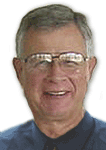
By Noel Widdifield |
Author
Bio
A few years ago, Outdoor Railroader changed its name to Finescale Railroader and changed the format to include coverage of other scales. Many believe that was the beginning of the end for the magazine that had come to represent the model railroader in Large Scale. Come read this exclusive interview with Russ and find out the details behind running a magazine in the world of Large Scale Trains.
|
Effective January 1, 2007, the two remaining annual issues of Finescale Railroader magazine were discontinued and replaced by a Modelers' Annual in addition to the Logging, Mining & Industrial Annual and the Narrow Gauge Annual published by Westlake Publishing. Annual subscriptions will no longer be offered for the publications. This brings to a close an era where two magazines were available to Large Scale hobbyists. The magazine that began as Outdoor Railroader in 1991 will no longer be available to the hobby. A few years ago, Outdoor Railroader changed its name to Finescale Railroader and changed the format to include coverage of other scales. Many believe that was the beginning of the end for the magazine that had come to represent the model railroader in Large Scale. Other factors led to the demise of the magazine and we thought it would be interesting to examine those factors and also to learn a little about the man behind the magazine: Russ Reinberg. We got in touch with Russ, who is the editor/owner of Finescale Railroader, to ask what caused him to make this change for 2007. This article is based upon the three hours of conversation with Russ Reinberg, also known as Uncle Russ. Researching for the interview, we discovered that, in addition to running a publishing business, Russ is an accomplished jazz clarinetist with a CD called Blue Scarlett. We started the interview by talking about his music.
 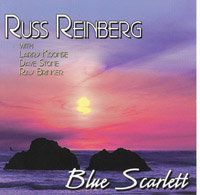 Russ grew up playing music. It was a big part of his early years. Russ was born in Los Angeles in 1948 and went to Birmingham High School. His next door neighbor was Sally Field. Directly behind him lived Billy Eckstein. Billy's son was Russ's best friend as he grew up. Russ's dad listened to jazz a lot and Russ heard some of the jazz greats from the 1940s swing era as his dad listened to his records. When Russ was about nine, his father gave him an old clarinet hidden in the closet from his youth when he had tried to play. Russ's parents allowed him to take lessons. Nearing high school graduation, his physician father asked him if he still planned to be a doctor, which was what Russ had thought he wanted to do. Russ replied that he really wanted to play the clarinet for a living. In "stunned disbelief" his then angry father told him that being a musician wasn't acceptable and if he felt really strongly about it, he could move out. Russ didn't move out, he just kept his music ambition to himself. After high school, Russ got a degree in ancient history from UCLA and went on to Berkley and was in a PhD program in ancient history. He was doing well but he realized that he would be about 30 when he finished his PhD. He also realized that there were few schools with openings for someone with a PhD in Ancient History. He realized his career path was limited with that kind of education. So he completed his Master's degree and went into broadcasting. Russ started in radio in LA and later moved to Sioux City, Iowa, Las Vegas, Nevada, and Tulsa, Oklahoma to be on television. Eventually he moved back to LA where he began working for himself. He tried sales for a while but quickly realized that selling wasn't his strength, so he quit and returned to his original desire: to become a professional musician. Russ says the trouble with being a musician is that usually music chooses you, you don't choose music. Musicians hear things in a different way than other people. Although Russ feels that he is pretty technically oriented, he has this quality he instantly sees in other musicians. He feels this makes him different from people who are not musicians and that it is not necessarily a blessing. Around 1980 he began practicing in earnest and before long was playing with some of the best jazz musicians in the world. He got into a Dixieland band called the Beverly Hills Unlisted Jazz Band. Actor George Segal played banjo and Russ became the bandleader. For the first several months the band was invited to the house of a guy who was big in show business. The group played jazz for the guests who included many big names in show business. Russ became pretty well known in the LA jazz scene for playing in the company of those show business celebrities.
In 1990 Russ had to make a decision between music and earning a living. Music was his passion and first choice in life, but as one of his music teachers noted, "He was playing an obsolete instrument for music that belongs in a museum". He sadly agreed and put his clarinet up in his closet. He didn't touch it again for 15 years. Looking for music jobs and staying up late to play engagements would distract him from his new focus, but he had little understanding of print media publishing. He felt that if he was going to make it publishing, he needed to give it his full attention. Russ became involved with Large Scale Outdoor Garden Railroads in his community while still playing the clarinet. About that time, he had met Larry Larsen who showed him how the Macintosh computer could handle graphics. Larry, at that time, was producing railroad graphics as dry transfer sets on the Mac. Larry urged Russ to start a magazine dedicated to the growing Large Scale train hobby and Larry's plan was he would do the page layout and graphics while Russ would own the company and write and edit articles. Russ decided the magazine should be complimentary to Garden Railways, being published by Marc Horovitz. He called Marc and asked him if he would have any objection to Russ starting a magazine for Large Scale and publishing it on the alternate months that Garden Railways wasn't published. Marc had no objections so Russ and Larry started the magazine, Outdoor Railroader (Realistic Large Scale Modeling), in October 1991. From the beginning, Kalmbach Publishing Company distributed the magazine for Russ and Larry. 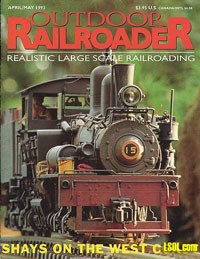 From the outset Russ felt that it was necessary for Outdoor Railroader to differentiate itself from Garden Railways. Russ and Larry used to advertise that Outdoor Railroader approached the hobby "from a different perspective". The low angle photography they favored was one obvious difference. But the orientation toward a more "indoor" model railroad approach was different, too.
The magazine drew a lot of interest. Russ was able to get a good base of advertisers and subscribers and the magazine took off. The content reflected Russ's belief that many readers would want a publication that treated Large Scale trains in the same way that other magazines approached small-scale trains. Russ also tried to make the trains in his magazine look prototypical. He has always been interested in accurately portraying the real world. The magazine was a highly polished and graphically rich publication. Its departments included new product introductions, readers' letters and photos, product reviews, an editor's page (more on that later), photos, drawings and data sheets, classified ads, a club directory and an index of advertisers. Those departments changed occasionally but basically remained the same throughout the publication of Outdoor Railroader. The articles featured layouts, scratchbuilding, kitbashing, modifications and operations. It always featured very high quality photos, usually done by the "OR Staff". That was Russ. 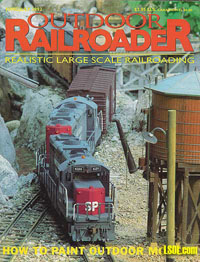 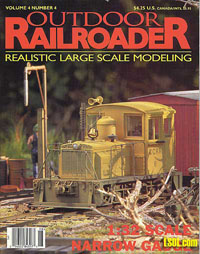 A very interesting and unusual feature that quickly replaced the usual editor's page in the magazine was something called the Railroad Man Adventure. A real life event became the springboard for the column. Russ's friend, Don Scott, was a lawyer nearing retirement and decided he would rather enjoy things other than working hard all of the time. He began inviting Russ on "adventures", that usually had something to do with a real railroad and were usually very involved. They took the form of a trip to somewhere that took a few hours travel in the Railroad Man's white Pontiac TranSport, a vehicle that resembled a white Dustbuster. 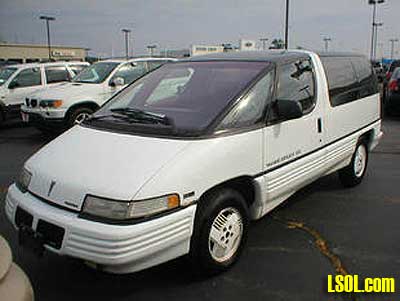
The Railroad Man Adventure would tell how Don and Russ looked for some long-forgotten place, structure, or tracks from a railroad that was no longer in existence. The trip would be broken up with blasts from the 700-megawatt sound system playing something like the Sounds of Small Steam at full volume. The adventure also included the Official Snack Food of Exciting Railroad Man Adventures. 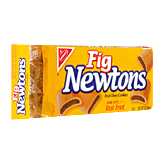 Sometimes the pair found what they were seeking and other times they did not, but they always ended the adventure with Don performing the secret railroad dance to the astonishment of whomever was nearby. It was always fun, but, alas, Don moved to Seattle and retirement and the adventures ended.  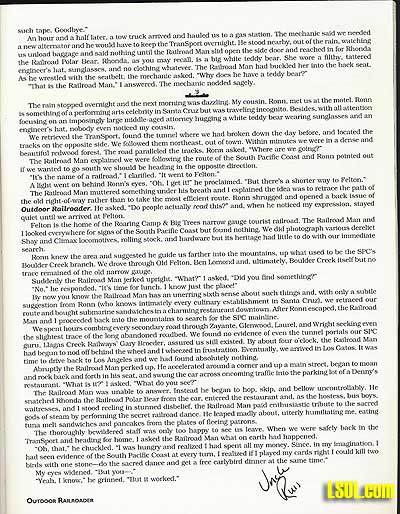 From the first issue Kalmbach Publishing Company agreed to distribute Russ's magazine and that worked out well until Kalmbach purchased Garden Railways magazine from Marc Horovitz in late 1996. Russ says that they did not tell him about the purchase until after it was completed. At that point, Kalmbach would distribute two magazines devoted to Large Scale, one it owned and one it didn't (Russ's). That led to problems for Outdoor Railroader. Russ realized it would be difficult to compete with his own distributor. This meant some things would have to change, such as stressing the differences between Outdoor Railroader and Garden Railways. This meant he would place more emphasis on the traditional (indoor) approach to model railroading.
In January 1997, Russ's publication came out looking pretty much the same as the November 1996 one, except the name had changed to Finescale Railroader (Includes Outdoor Railroader). 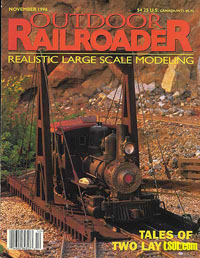 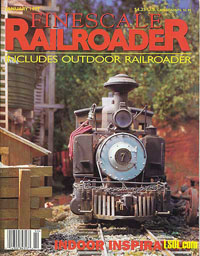 In that issue Russ explained that although there was a lot of talk and speculation about what the name change meant, nothing had really changed but the name. He said, "But (you) really have nothing to fear, and I want to reassure you of something: If you liked Outdoor Railroader, you will like Finescale Railroader. It is the same magazine and I am the same editor and publisher." But he went on to say, "Finescale Railroader will continue to present the highest quality models, dioramas, and layouts we can regardless of whether they are literally 'finescale'. We will continue to address the interest of Large Scale modelers. We will continue to discourage snobbery and attempt to keep both a balanced perspective and a sense of humor about our hobby. We will continue to illustrate our articles with examples of modeling in any scale, including 1:1, as long as they help to inspire you. Our goal is the same as it has been from the beginning: To unite large scale model railroading, indoors and out, with the rest of the hobby." This change in name and content provoked a huge amount of discussion within the Large Scale hobby community. Some readers and advertisers liked the change and some did not. The change to multiple scales created problems among some Large Scalers. Many saw the change as an abandonment of the Large Scale focus that made the magazine popular with them. Some Large Scale advertisers also reacted to the change and withdrew advertising but advertisers in other scales picked up the slack. A couple of years before Larry Larsen had moved to Colorado and, by 1998, his participation in the magazine ended.
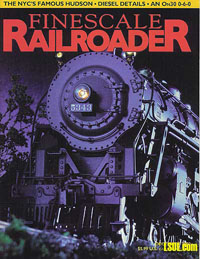 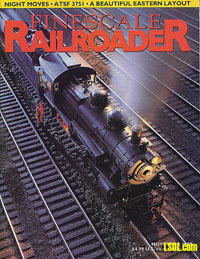 In 1999 several things happened to make things better for Russ and the magazine. The two major standard gauge manufactures in Large Scale, USA Trains and Aristo Craft, began to produce higher quality standard gauge locomotives and cars. Additionally, Bachmann already had begun their series of high quality 1:20.3 narrow gauge locomotives, as did Accucraft. This caused many new owners of these models to start sending in articles that fit what Russ now needed for his magazine. Over the years Outdoor Railroader and Finescale Railroader had sold very well through hobby shops and the readership increased a little, but newsstand and bookstore distribution always had cost rather than earned money so Russ had to cut expenses resulting in the magazine disappearing from bookstores. All of this resulted in increased profits for the magazine. 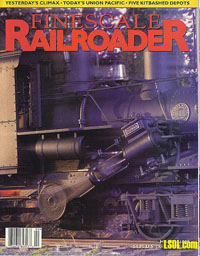 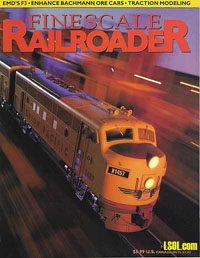 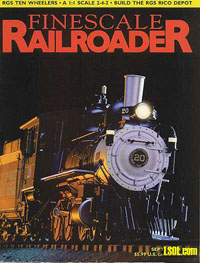 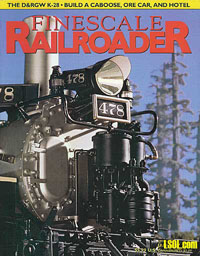
Russ then started a website for the magazine that featured the cover, reader's photos, letters, modeler's forum, reader survey, classified ads and links to readers and advertisers. It also featured the table of contents and photos from the current publication. And it offered free digital downloads of the complete magazine. However, relatively few people took advantage of that. 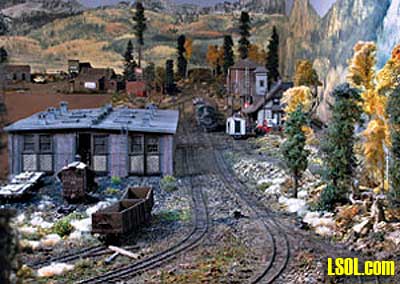 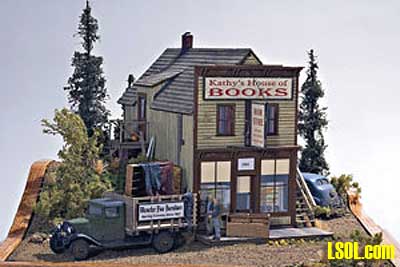 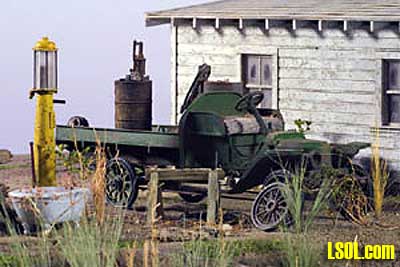 In 2002, Finescale Railroader magazine went from publishing every other month to two magazines per year along with two special issues, the Narrow Gauge Annual and the Logging, Mining & Industrial Annual, each published once a year. The change was a response to a gradual downturn in the overall hobby and the resulting decline in advertising in the industry.
Today the Finescale Railroader website has an announcement that reads, "Effective January 1, 2007 we will stop publishing the two semi-annual FINESCALE RAILROADER magazines. In their place will be the existing softbound books (the LOGGING, MINING & INDUSTRIAL ANNUAL and the NARROW GAUGE ANNUAL) along with a new third book, the MODELERS' ANNUAL." This marks the fourth chapter in a history that has produced some very fine publications. As Russ explained, he considered it a matter of survival. 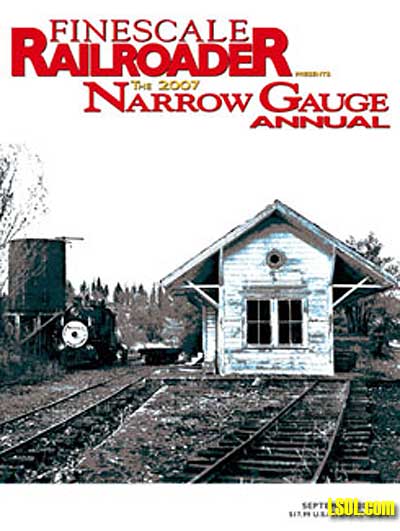 Russ has been accused of being a "rivet counter" and that has hurt his reputation within the Large Scale community. He believes that accusation is very inaccurate. It probably came about because most Outdoor Garden Railway hobbyists are not interested in prototype railroads and modeling fidelity. They tend to view those people with that type of interest with distrust. Most want to buy their trains and just run them as they come out of the box. Many in the hobby have never known much about railroading or never had a train set before they saw one running in a holiday or garden display. Some only started because they thought the trains would look "cute" running in their garden. It is estimated that fewer than 10% of those in Large Scale really care anything about modeling fidelity.
Russ has always been an advocate of manufacturers producing models in the correct scale for the track gauge. That means 1/20.3 in narrow gauge and 1/32 in standard gauge. But Russ explained that he has stated several times in print that his feeling about manufacturing does not extend to individual hobbyists. He has stated individuals should be free to approach the hobby in any way they want regardless of scale, gauge, or accuracy. He says that some people chose to ignore his overall opinion and that caused some issues within the Large Scale community. Not everyone agrees that everything should be produced in those scales. Again, because true modelers in Large Scale represent only a small minority, this issue has caused Russ to be criticized for his stand. He may be a major reason that manufacturers have focused on 1/20.3 narrow gauge products. There are many Large Scalers who have a considerable investment in 1/24 and 1/22.5, who either don't care about the difference or see 1/20.3 as a threat to their scales. Russ is quick to point out that he has always been open to all views in the hobby and illustrates that with his willingness to publish reader's photos of their creations regardless of scale or fidelity. Beginning in about 1998, most of his articles, features and photos, however, have been of very high-quality models usually in the "correct" scale. Russ explains that became necessary as readers in the smaller scales began to outnumber the Large Scale hobbyists who bought Finescale Railroader. The small-scale hobbyists wanted accuracy and, he believed that to stay profitable, the magazine had to provide it. Russ solicits the articles for his magazine based upon what the majority of his readers want to see. He photographs those models and railroads that he believes are the best available. 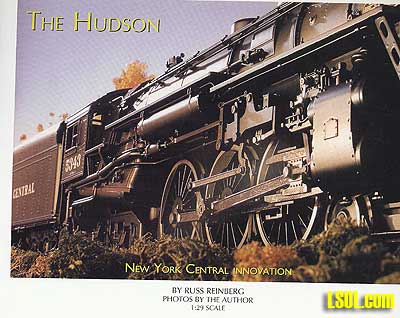
Russ is a little discouraged by all of the controversy and by the fact that the Large Scale community never strongly supported his magazine. People in the Large Scale community at large generally have no opinion about Russ, but a small number of highly vocal people have strong negative things to say about Russ and Finescale Railroader. Subscriptions initially declined with the change from Outdoor Railroader to Finescale Railroader, although hobby shop sales increased. Advertising has continued to decline for all small publishers although Finescale Railroader has retained more than nearly all of his colleagues. Still, the majority of small-scale manufacturers have not seemed interested in the magazine. The sales for the Narrow Gauge Annual and the Logging, Mining & Industrial Annual have been strong and Russ expects that to continue. Russ points out that, since Kalmbach's purchase of Garden Railways, the entire evolution of his publication has been the result of an effort to remain in business. He says that if he had not made the changes he did, he would have gone out of business long ago. Russ has a long-abandoned outdoor railroad and it was the first real layout that Russ ever built. His was one of the very first Large Scale railroads in California. The first year he had a lot of fun with it. He spent a lot of time running it and taking pictures and videos. The second year he ran it three or four times. The third year he used it for photography for the magazine and by the fourth year and after, he only used it for his annual train meet. (He has now basically abandoned it.) He had train meets at his house since 1986. He does have a small one-foot by six-foot On30 switching layout, a two-foot by eight-foot HO switching layout that is finished without scenery and an unfinished two-foot by eight-foot HOn3 layout under the HO one. It has been around since 1970 and serves as a storage shelf. Layouts have never been Russ's major focus. He has continued to build fine scale models over the years. Many were featured in his magazines. Usually, they were found on modules or photographed on his backyard railroad. They were always very authentic and very high quality. 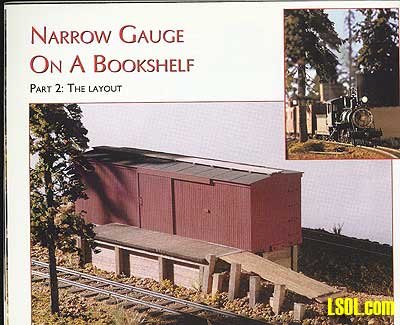
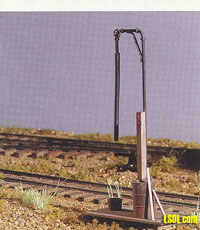 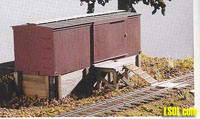 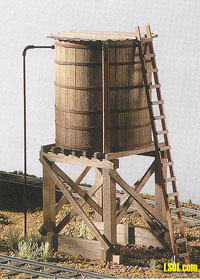 The photos were usually part of a "how to" article and were accompanied by detailed instructions on how to build the models. 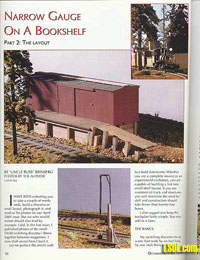 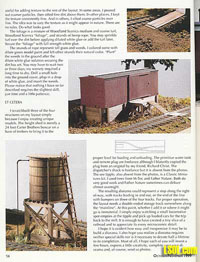 When we asked Russ for a picture of himself to include with the article, he told us that he has intentionally never had his picture in his publications and wasn't going to start now. We told him that many of us have a mental picture of him and he says that is what he wants. He believes that if readers see a picture of the person doing the writing, then that colors their perception of what they read. He doesn't want his readers to have their perceptions of him influence what they are reading. He wants them to judge what they read based upon the content alone. The future holds much for Russ as he focuses his publications on the three soft-copy books he is now publishing. LOGGING, MINING & INDUSTRIAL ANNUAL, NARROW GAUGE ANNUAL and the MODELERS' ANNUAL. He feels that publishing those three small books each year will allow him to have a more tolerant, stable readership. With the expected increased sales of these books, he should enjoy higher profits and have more enjoyment in what he does. Oh, by the way, the clarinet is out of the closet again. All covers, photos and articles copied from Outdoor Railroader and Finescale Railroader and used with permission from Westlake Publishing Company. - http://www.finescalerr.com/ Top of Page
|



